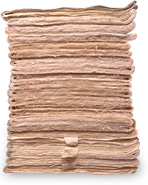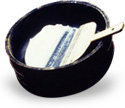
Main materials used for mounting are paper, mounting silk and paste.

Japanese paper handmade in the cold season is said to have good quality.
Paper made in mid-winter with limpid water and in the midst of fresh, clean air is sharp and crisp.
Rather than using it immediately after it is made, paper is kept stored for a while to give it time to mature.
Many types of paper including minogami, sekishushi, and kurotanishi are stored on shelves, maturing and awaiting their turn to be used. Recycled paper that young restorers have spent nights joining for practice are also stored in rolls; they will eventually be used for under-papering Japanese sliding doors(fusuma) and folding screens (byobu).

Aged mounting silk is most suitable for aged art objects.
It would be best if mounting silk dating to the same period as the art object could be found. However, since this is very difficult, patterns are copied from celebrated fabric or antique patterned fabric, and newly woven. Mounting silk woven anew for a hanging scroll or hand scroll will be handed down for use in the next generation. In fact, most of the fabrics that are selected for mounting and the ideas associated with the selection and combination of fabrics for mounting are those that have been handed down to us from our predecessors. Thus, many aspects of tradition associated with mounting are handed down from generation to generation.

New paste made by cooking wheat starch is used for the initial lining of the art object and mounting silk.
Aged paste is made by storing new paste cooked during the coldest time of the year in an earthenware pot for about 10 years. Since it is not strongly adhesive, it will not cause creases due to hardening after it has been used for lining. For this reason, it is used for subsidiary, overall and final linings.
Phone: +81-75-371-1593 / FAX: +81-75-371-6838
Copyright © The Usami Shokakudo Company Limited. All rights reserved.



